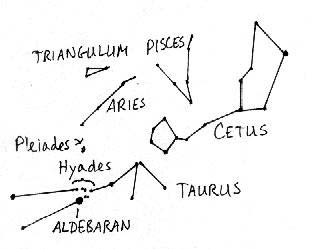In ancient myths, bulls represented strength and fertility. The majestic animals were even worshiped in many cultures. It is no surprise to a savvy astronomer, then, that the legends of Taurus are linked to that randy big Kahuna of gods, Zeus.
When Zeus fell in love with Phoenician princess Europa, he decided the most logical way to get her attention was to turn himself into a white bull. After all, what woman can resist a friendly white bull? Apparently Europa couldn't. When she saw the beautiful animal grazing with her father's herd near the water, she approached it. The bull knelt down, allowing Europa to climb on. Having gained the object of his affection, the bull leapt up and headed for the sea, where he swam to Crete. There Zeus made Europa his mistress. Later one of their sons, Minos, became the king of Crete.
Another less romantic, but possibly more satisfying, legend involves another one of Zeus's girlfriends. When Hera learned that her husband was having an affair, she put an end to the affair by changing the object of his affections into a white bull.
 Taurus is visible in the east in the early evening. The brightest star, Aldebaran (al-DEB-uh-ran), is about ten degrees (one fist width) below the Pleiades. In Arabic, the star's name means "follower," and indeed the star follows the Pleiades across the sky. It is a near neighbor to us, at only 65 light years away, and appears red or orange. It is sometimes referred to as the eye of the bull.
Taurus is visible in the east in the early evening. The brightest star, Aldebaran (al-DEB-uh-ran), is about ten degrees (one fist width) below the Pleiades. In Arabic, the star's name means "follower," and indeed the star follows the Pleiades across the sky. It is a near neighbor to us, at only 65 light years away, and appears red or orange. It is sometimes referred to as the eye of the bull.To the right of Aldebaran, an open cluster of stars makes up the bull's head. This cluster, the Hyades (HIGH-ah-deez), covers 8 degrees of the sky, or 16 moon widths. These stars are the cluster nearest to earth, approximately 150 light years away. In legend, the Hyades were also daughters of Atlas, and half sisters to the Pleiades. They are sometimes referred to as The Piglets. Like their sisters, they are best viewed with binoculars or the naked eye.
The bright stars of the Hyades form a sideways V, which extends to the left to become the horns of Taurus. The forelegs of the bull are fainter stars to the right. The hindquarters presumably, have not yet emerged from the sea. Indeed, just beyond the bull's front legs is the last of the water constellations, large and faint Cetus (SEE-tus), the Whale. Cetus is the beast who was threatening Andromeda before Perseus rode to her rescue.
Planet watch: On November 25, look for bright Venus to the right of the crescent moon, low in the southwest just after sunset.
Astro freebie: Jackie Gleason always said, "To the moon!", but NASA is offering members of the public a chance to go to a comet. In December, the Deep Impact spacecraft will be launched, set to rendezvous with, and bore into, Comet Tempel 1 in 2005. Visit http://deepimpact.jpl.nasa.gov/sendyourname/index.html to add your name to a CD that will be mounted on the impactor. It's free, and you even get a printable certificate to recognize your participation.

The Piker Press moderates all comments.
Click here for the commenting policy.